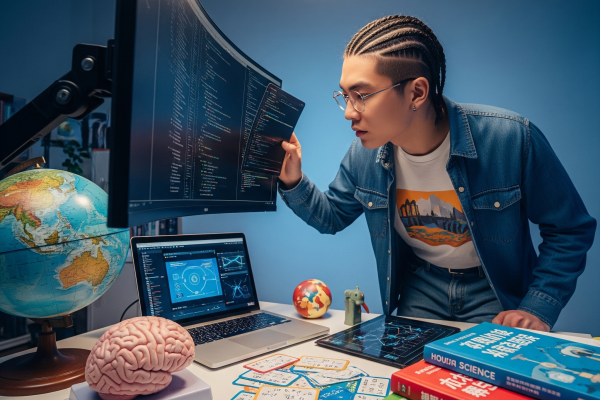
We live in an age of information abundance. Want to learn a new skill, dive deep into a fascinating subject, or simply expand your horizons? The resources are practically limitless. But with so much available, a common question arises: where do you even begin? And more importantly, how do you ensure your learning journey is effective for you?
The answer lies in cracking the code to your own unique learning style and designing a personalized learning journey. Gone are the days of one-size-fits-all education. Self-study, at its most powerful, is about taking the reins and crafting an educational experience tailored to your individual needs, preferences, and goals.
Why a Personalized Approach Matters
Think back to your own learning experiences. What methods truly resonated with you? Were you a visual learner who thrived on diagrams and videos? Perhaps you were more hands-on, preferring practical application and experimentation. Or maybe you learned best through discussions and collaborative projects.
A personalized learning journey acknowledges these individual differences and leverages them for maximum impact. It offers several key advantages:
Increased Engagement: When you're learning in a way that aligns with your natural inclinations, you're more likely to stay interested and motivated.
Improved Retention: Understanding comes easier and sticks longer when the learning process caters to your strengths.
Enhanced Efficiency: You spend less time struggling with methods that don't work for you and more time absorbing and applying knowledge.
Greater Autonomy and Ownership: Taking control of your learning fosters a sense of responsibility and empowers you to become a more effective lifelong learner.
Cracking the Code: Steps to Design Your Personalized Learning Journey
So, how do you embark on this exciting journey of self-directed learning? Here's a step-by-step guide to help you crack the code:
1. Define Your "Why": Goals and Motivations
Before diving into methods, clarify what you want to achieve. What are your learning goals? Are you looking to acquire a specific skill for career advancement, explore a personal interest, or deepen your understanding of a particular subject? Having clear objectives will provide direction and help you tailor your approach.
2. Know Thyself: Identify Your Learning Style(s)
Reflect on how you learn best. Consider these common learning styles:
Visual: Do you learn best through seeing things? Charts, graphs, diagrams, videos, and visual aids are your allies.
Auditory: Do you prefer listening? Podcasts, audiobooks, lectures, and discussions might be ideal.
Kinesthetic/Tactile: Do you learn by doing? Hands-on activities, experiments, building, and physical movement can be highly effective.
Reading/Writing: Do you excel through written words? Books, articles, notes, and writing summaries can be your go-to methods.
While you might lean towards one or two dominant styles, don't be afraid to experiment with others. You might discover unexpected strengths!
3. Explore Diverse Learning Resources and Methods
Once you have a better understanding of your learning style, explore the vast array of resources available:
Online Courses and Platforms: Websites like Coursera, edX, Khan Academy, and Udemy offer structured courses on virtually any topic.
Books and Articles: Traditional resources remain invaluable for in-depth knowledge.
Podcasts and Audiobooks: Perfect for learning on the go.
Videos and Documentaries: Great for visual learners and understanding complex concepts.
Interactive Exercises and Quizzes: Test your knowledge and reinforce learning.
Projects and Practical Applications: Apply what you learn through real-world tasks.
Community Forums and Study Groups: Engage with other learners, ask questions, and share insights.
Mentors and Experts: Seek guidance from those who have already mastered what you're trying to learn.
4. Curate Your Learning Path: Select and Combine Methods
Now, it's time to be the architect of your own learning journey. Based on your goals, learning style, and the available resources, select the methods that you believe will be most effective and engaging for you. Don't be afraid to combine different approaches. For example, you might watch a video lecture (visual/auditory), read a chapter in a book (reading/writing), and then work on a related project (kinesthetic).
5. Experiment, Evaluate, and Adapt
Your initial plan isn't set in stone. As you progress through your self-study, pay attention to what's working and what isn't. Are you feeling engaged and understanding the material? Or are you struggling to stay focused and retain information?
Be willing to experiment with different methods and resources. If a particular approach isn't yielding the desired results, don't hesitate to adjust your strategy. This iterative process of evaluation and adaptation is crucial for a successful personalized learning journey.
6. Track Your Progress and Celebrate Milestones
Set realistic milestones and track your progress. This will help you stay motivated and see how far you've come. Celebrate your achievements, no matter how small, to reinforce positive learning habits.
The Power is in Your Hands
Designing your own personalized learning journey is an empowering process. It puts you in control of your education and allows you to learn in a way that truly resonates with you. By understanding your goals, learning style, and the vast resources available, you can crack the code to effective self-study and unlock your full learning potential. So, take the first step today and begin crafting the educational adventure that's perfectly designed for you.